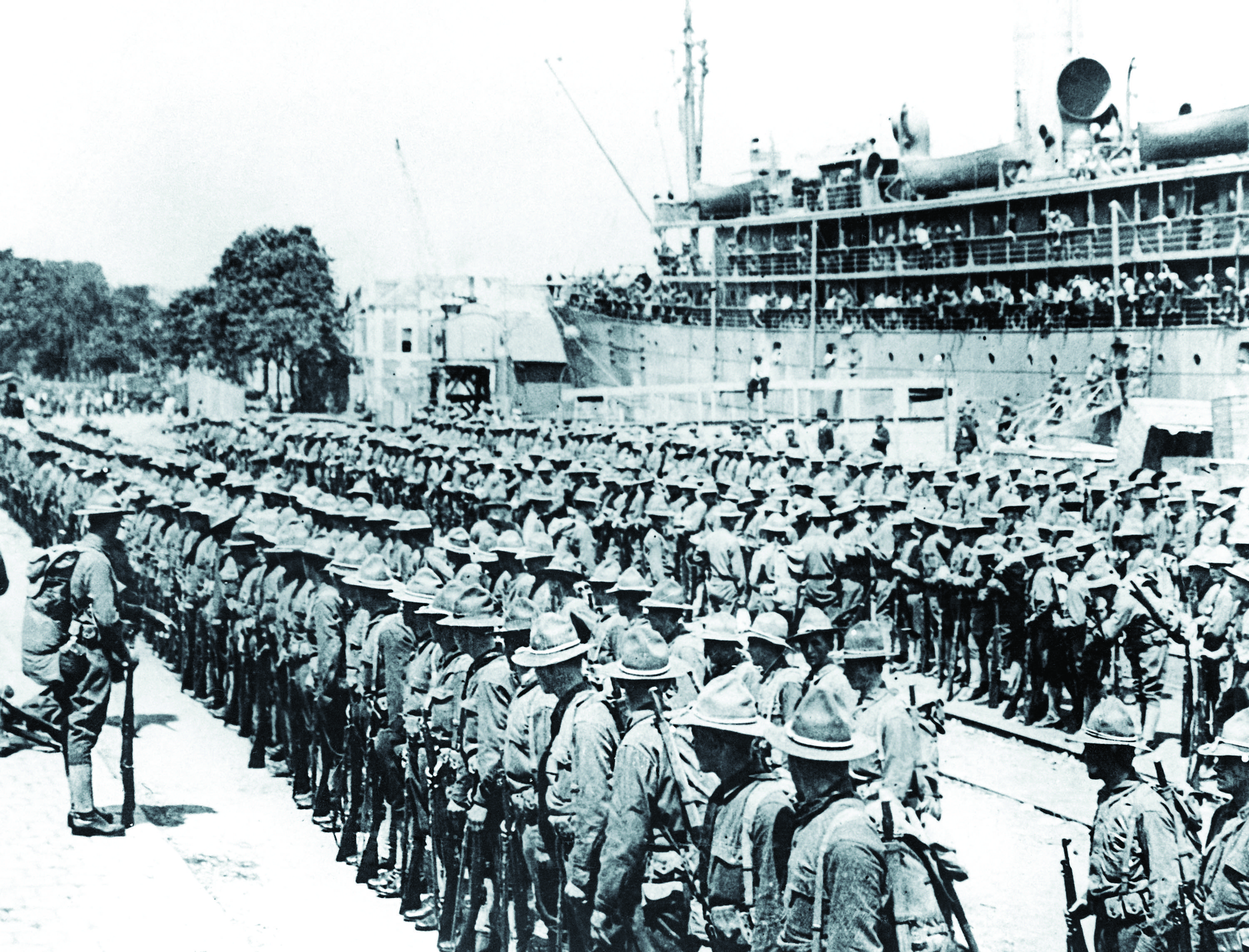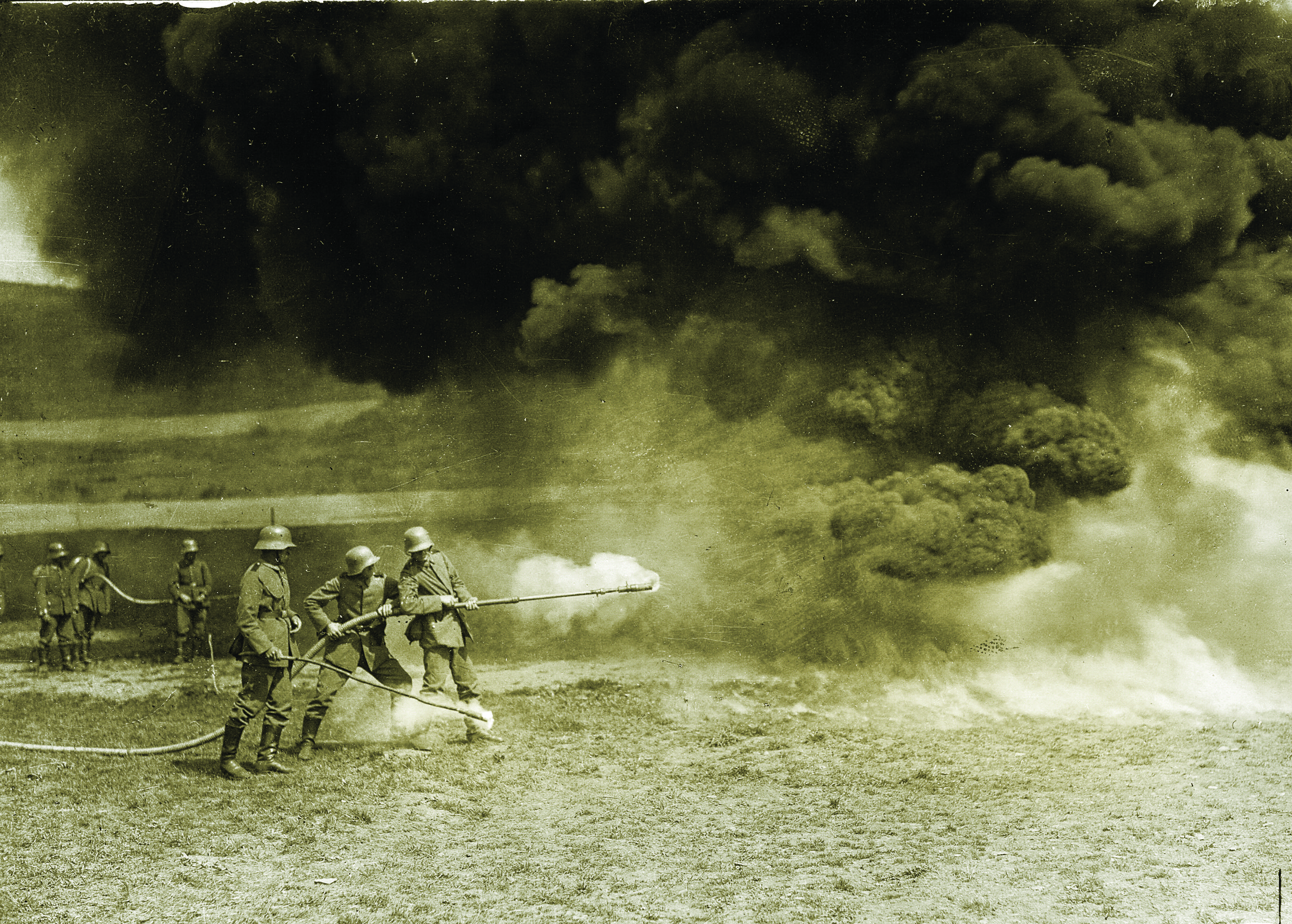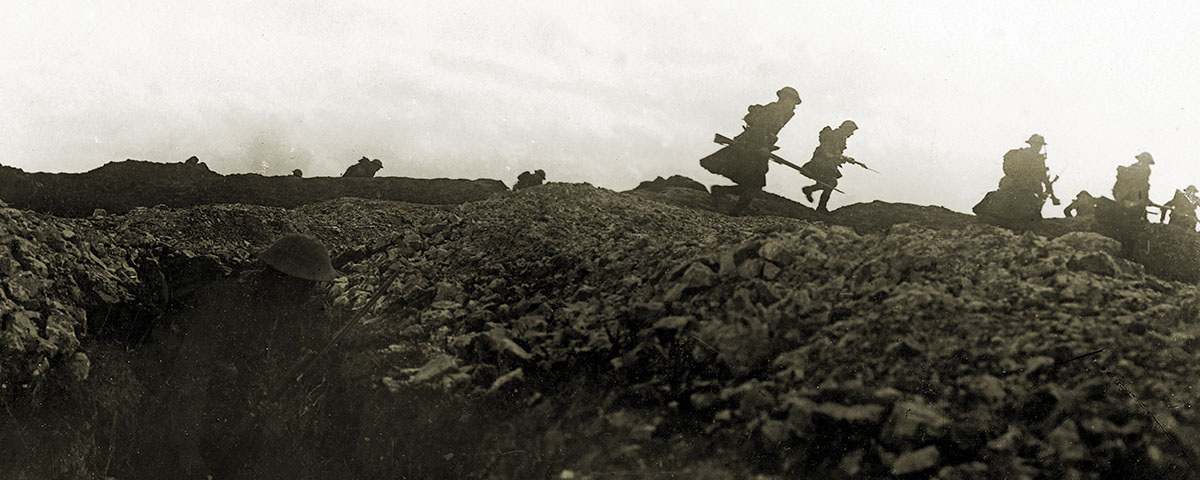In the closing days of World War I U.S. commanders tangled their forces in a costly race toward a pointless objective
The monument rises from a hillside on the west bank of France’s Meuse River, overlooking the town of Sedan less than a mile downriver on the opposite bank. Placed after World War I by the Society of the 1st Infantry Division, it marks the spot of the forward-most U.S. advance during the offensive that ended the war and is intended to commemorate a great American feat of arms. What became known as the “Race to Sedan” was anything but. In fact, it was among the worst blunders of the war by senior U.S. commanders. The 1st Division had no business being where it was, and far too many American soldiers paid the price for what was little more than a naked glory grab of dubious tactical or operational value.
The Meuse-Argonne offensive started on Sept. 26, 1918, as a combined Franco-American operation. Its objective was the vital German rail junction at Mézières, a dozen miles north of Sedan and more than 50 miles from the line of departure—a huge distance by World War I standards. Attacking north from just west of Verdun, the U.S. First Army had the Meuse River on its right flank. Three American corps extended some 20 miles to the east through the Argonne Forest. The French Fourth Army, commanded by Gen. Henri Gouraud, was on the American left flank. Initially, Gen. John J. Pershing, commander of the American Expeditionary Forces (AEF), was dual-hatted as the First Army commander. Two weeks into the battle the U.S. Second Army was activated on the opposite bank of the Meuse, and Pershing ceded command of the First Army to Lt. Gen. Hunter Liggett. Pershing remained the AEF commander, which by then was officially an army group independent of European command.

The American attack through the densely wooded and hilly Argonne bogged down almost from the start. The Germans had occupied the sector for nearly four years and were masters of defensive warfare. Their overall defensive zone was called the Hindenburg Line, which in the Argonne sector comprised three deeply echeloned and heavily fortified lines, each comprising three or more mutually supporting trench lines. The Germans had almost every inch of ground mined, wired and covered by interlocking machine gun fire. Every piece of high ground was a strongpoint, supported by artillery and trench mortars. Pershing expected his troops to advance 8 miles on the first day and reach the second German line, known as the Kriemhilde Position. But the maximum advance at any point on that day was 5 miles.
American tactics only made things worse. Pershing was the brilliant organizer of the AEF, but he did not understand the kind of war he was fighting. Prior to his arrival in France he had significant personal combat experience, but it was all low-intensity and frontier fighting, in no way comparable to history’s first modern industrialized war. The Americans came late into the conflict, and Pershing was infused with a deep belief in American exceptionalism and an unstinting faith in superior U.S. marksmanship. Ignoring the experiences of the previous three years, he believed the tired and dispirited enemy soldiers hunkered down in their trenches could never stand up to the fresh and robust American Doughboys. Accordingly, he discounted the effects of weapons like machine guns, trench mortars and artillery. Pershing’s overriding doctrine was “open warfare,” which all too often meant relentless frontal attacks. Within the first year of the war the other Allies had learned the hard way the “cult of the offensive” did not work on the modern battlefield.
Command and staff experience was the American Achilles’ heel. Most of the U.S. division and corps commanders had never led anything larger than a battalion under fire. Not since the Civil War had staff officers been required to plan and coordinate an operation so large, and warfare had become far more complex a business. The Americans were being forced to climb a very steep learning curve, very fast. The French, Germans and, to an even greater extent, the British had all gone through a similar process at the outset of the war, but by September 1918 those armies had been at it for four years.
Logistics was a particular nightmare for the Americans. Each corps had only a single main supply route leading into the forest, each of which was little better than an unimproved dirt road. Miles-long traffic jams made it almost impossible for rations, ammunition and supporting artillery to get forward and for the wounded to get back. During a visit to the front lines on September 29, French Prime Minister Georges Clemenceau’s limousine got bogged down in an immense jam in the middle of the forest as he approached the American front lines, stranding him for hours. Infuriated, Clemenceau fired off a note to Marshal Ferdinand Foch, the Allied supreme commander, calling for Pershing’s dismissal and demanding U.S. President Woodrow Wilson be informed of the AEF commander’s incompetence.
It was not the first time Pershing and Clemenceau had clashed, and it would not be the last. British Prime Minister David Lloyd George and British Expeditionary Force commander Field Marshal Sir Douglas Haig also thought Pershing should be sacked. Since September 1917 Pershing had resisted all efforts to attach the arriving American battalions and regiments to French and British divisions for advanced training. Pershing steadfastly refused on the grounds that his command mandate from Wilson made it clear the American forces were to fight as an independent army and not serve as fillers for the Allies. Pershing also did not want his fresh and spirited troops contaminated with what he considered mistaken European notions of trench warfare.
The Allied leaders were confounded by what they perceived as Pershing’s megalomania, while he in turn believed they sought to minimize the American contribution to the final victory over Germany. “If General Pershing continues along his current path,” Clemenceau wrote in early October, “he is risking a disaster.” Days later Lloyd George criticized Pershing as “most difficult,” and the First Army as “quite ineffective.” Pershing’s rapport with his fellow Allied military commanders was not much better. His relationship with Foch was icy at best; Pershing regarded the Allied supreme commander as “haughty, Napoleonic and moderately conceited.” The American commander’s relations with French army commander Philippe Pétain were a little better, although Pétain was also quite critical of the U.S. performance in the Argonne. Back on April 24 Gen. Sir Henry Wilson, the British chief of the Imperial General Staff, had confided to his diary he considered Pershing “so stupid, so narrow, so pigheaded.” Following a meeting a week later Haig had written in his own diary, “I thought Pershing very obstinate and stupid.”
After five weeks of bloody and brutal fighting the Americans finally broke through the Kriemhelde Position, having advanced some 13 miles. On the night of November 1 the Germans withdrew to their last line, the only partially completed Freya Position. By the following day, however, they were in full retreat. Their intent was to break contact with the Allies in order to establish a new defensive line running from Antwerp to the Meuse. The Americans pursued, advancing some 17 miles between November 2 and 7. Pershing had finally secured his long dreamed-of open warfare.
The town of Sedan lay a dozen miles southeast of the main objective of Mézières. Sedan loomed large in the French national psyche. It was there in battle on Sept. 2, 1870, Emperor Napoléon III surrendered to Prussian King Wilhelm I during the Franco-Prussian War. In the aftermath of that war Wilhelm became the first emperor of a united Germany, and France lost the provinces of Alsace and Lorraine to Germany. France wanted revenge for 1870, and the boundary between the French and the AEF swung just to the south of Sedan, placing the town well within the French zone. But after the American breakout on November 1, the French had trouble keeping up on the left flank.
With his own troops closing on Sedan faster than Gouraud’s, Pershing saw an opportunity to vindicate both the AEF’s role in the offensive and his open warfare doctrine. On the morning of November 3 he met with Gen. Paul Maistre, the commander of the French Central Army Group and Gouraud’s superior. Maistre reluctantly agreed the rail line between Mézières and Sedan was of such importance the Americans should take the town if the French Fourth Army continued to lag. At that point the 42nd Division on the American left flank was the closest to Sedan, and the 77th Division next on the right, the two comprising I Corps. On the 77th Division’s immediate right was V Corps’ 1st Division.
At 4:30 in the afternoon on November 5 Brig. Gen. Fox Conner, the AEF operations officer, showed up at the field office of Colonel George C. Marshall, operations officer of the First Army. Conner handed Marshall a draft message:
General Pershing desires that the honor of entering Sedan should fall to the First American Army. He has every confidence that the troops of the I Corps, assisted on their right by the V Corps, will enable him to realize this desire.
In transmitting the foregoing message, your attention is invited to the favorable opportunity now existing for pressing our advantage throughout the night.
Marshall was reluctant to issue the order immediately, as neither Gen. Liggett, the First Army commander, nor his chief of staff, Brig. Gen. Hugh Drum, were at headquarters. Marshall finally agreed to release the order if neither returned by 6 p.m. Conner left for AEF headquarters at 5:30, and Drum returned shortly thereafter. After reviewing the message, Drum added a final sentence to the second paragraph: “Boundaries will not be considered binding.” The message went out. Liggett did not even learn of the order until about noon on November 7.
What Drum’s added last sentence meant was that the boundary between the U.S. First Army and lagging French Fourth Army would not be binding. Some U.S. commanders, however, assumed the AEF’s own divisional and corps boundaries would also not be binding. Unit boundaries that define tactical areas of responsibility are the most fundamental and important of all standard operational control measures. The order was a recipe for disaster.
When V Corps commander Maj. Gen. Charles P. Summerall got the directive, he apparently concluded that rather than assisting I Corps on its right, as the first paragraph of the order specified, V Corps had carte blanche to lunge straight for Sedan. Summerall handed a copy of the directive to Brig. Gen. Frank Parker, commander of the 1st Division, and told Parker that while he could not give detailed orders for the execution of the directive, he expected Parker to be in Sedan the next morning. “I understand, sir,” Parker replied. “I will now give my orders.”
The confusion only spread. In his World War I memoirs Marshall states, “It developed afterwards that General Pershing, in person, had given instructions to General [Joseph] Dickman of the I Corps about 5 o’clock that afternoon to advance directly on Sedan.” If so, those instructions preceded Summerall’s distribution of the directive to his divisional commanders. In his memoirs Pershing says nothing about such orders to Dickman.
Still unaware of the November 5 directive, Liggett intended to wheel the First Army to the east and coordinate with the Second Army, which was gearing up operations on the other side of the Meuse. On November 6, however, Parker—believing he was following both Pershing’s directive and Summerall’s orders—turned the 1st Division to the west and sent his tired troops on a forced march directly across the front of the 77th Division and deep into the sector of the 42nd Division. Utter chaos ensued. With friendly troops to their front, the two I Corps divisions were forced to stop moving and firing. As the 1st Division continued to drive forward through the night of the 6th, U.S. troops shot at each other in the dark.
But friendly fire was only one of the 1st Division’s problems. During the entire maneuver the division’s right flank was wholly exposed to German fire from the far side of the Marne. Meanwhile, the lead elements of the 77th Division reached the Marne about 3 miles southeast of Sedan on the 7th, only to be cut off by the 1st Division advancing across their rear. By that time the French Fourth Army had pretty well caught up with the Americans, but the 42nd Division had shifted left into their sector, confounding the French operations. The 1st and 42nd Divisions then engaged in a race to reach Sedan before the French.
In one of the more absurd episodes of the entire fiasco 1st Division soldiers temporarily “captured” at gunpoint Brig. Gen. Douglas MacArthur of the 42nd Division. Due to the latter’s penchant for flamboyant uniforms and insistence on wearing a peaked cap in combat instead of a helmet, an overeager lieutenant of the Big Red One mistook the commander of the 84th Infantry Brigade for a German officer. More tragic than absurd was the number of casualties (80 killed and 503 wounded) the 1st Division sustained that November 6 and 7 in what Liggett later decried as a tactical atrocity. Had the depleted German forces been in better position to respond, the toll might have been far greater.
There was no justification for such a reckless maneuver, especially one that violated the most fundamental principles of tactics. By November 1918 the Germans were all but beaten. Everyone knew it, especially the Germans. Prince Maximilian of Baden, Germany’s new chancellor, had been exchanging peace feelers with the Allies since mid-October. On the northern end of the Western Front the Germans were reeling under the relentless hammering of British and French offensives. Certainly, there was a need to maintain steady military pressure on the Germans all along the line until they finally threw in the towel, but there was no strategic or operational advantage to securing Sedan itself. A desire for acclaim and praise drove that race—one that went unfinished. When the Armistice went into effect on November 11, Sedan remained in German hands.

Many American generals at the time believed Summerall should have been court-martialed, but Pershing downplayed the whole affair as a misunderstanding. In the first place, there was the question of his own responsibility for the mess. Second, although Pershing was notorious for firing National Guard generals at the drop of a hat, he had a reputation for going easy on regular Army generals, especially fellow West Pointers like Summerall.
In his World War I memoirs, Pershing praised the soldiers of the Big Red One even while admitting the race to Sedan never should have happened: “The troops of the 1st Division carried out this unnecessary forced march in fine spirit despite their tired condition.” He made no mention of the casualty count. The American commander also tacitly laid the blame at Summerall’s feet: “Under normal conditions the action of the officer or officers responsible for this movement of the 1st Division directly across the zones of action of two other divisions could not have been overlooked, but the splendid record of that unit and the approach of the end of hostilities suggested leniency.”
In his own posthumously published memoirs Summerall wrote that when he told Parker to “be in Sedan the next morning,” he assumed Parker would do so by first crossing the Meuse from his present position 7 miles southwest of Sedan and then advancing on the town from the far bank. Summerall said he was “amazed to learn” Parker had started moving laterally across the sectors of the adjacent American divisions rather than crossing the river first. The implication in Pershing’s memoirs infuriated Summerall, who had just retired as Army chief of staff and was about to assume the presidency of The Citadel, the Military College of South Carolina. He reportedly prepared a rebuttal, accusing Pershing of disloyalty, but friends talked him out of releasing it to the press.
The animosities resulting from the race to Sedan continued to ripple through the senior ranks of the U.S. Army during the interwar years. Four of the six chiefs of staff of the Army during that period—Pershing, Summerall, MacArthur and Marshall—had been involved in the November 6–7 fiasco to one degree or another. The ultimate price, however, was paid by those soldiers killed or missing whose names are inscribed in bronze on the 1st Division monument still standing just shy of Sedan.
David T. Zabecki is HistoryNet’s chief military historian. For further reading he recommends The American Army in France, 1917–1919, by James G. Harbord; My Experiences in the World War, by John J. Pershing; and The Way of Duty, Honor, Country, by Charles Pelot Summerall.

